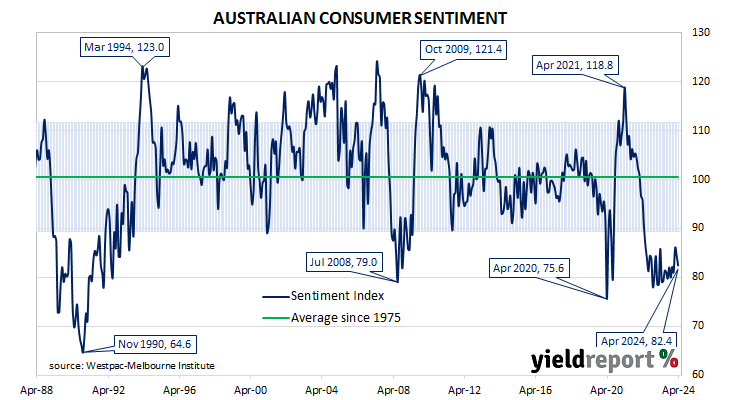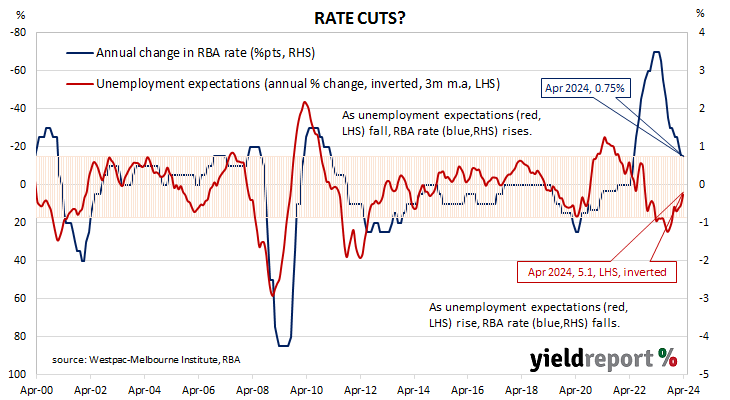Summary: Westpac-Melbourne Institute consumer sentiment index down in April; pessimism showing few signs of lifting; ACGB yields move lower; rate-cut expectations firm; absence of sentiment recovery reflects nature, duration of Australia’s inflation challenge; three of five sub-indices lower; fewer respondents expecting higher jobless rate.
After a lengthy divergence between measures of consumer sentiment and business confidence in Australia which began in 2014, confidence readings of the two sectors converged again in mid-July 2018. Both measures then deteriorated gradually in trend terms, with consumer confidence leading the way. Household sentiment fell off a cliff in April 2020 but, after a few months of to-ing and fro-ing, it then staged a full recovery. However, consumer sentiment has languished at pessimistic levels since mid-2022 while business sentiment has been more robust.
According to the latest Westpac-Melbourne Institute survey conducted in the first week of April, household sentiment remains at quite a pessimistic level. Their Consumer Sentiment Index declined from March’s reading of 84.4 to 82.4, a reading which is significantly lower than the long-term average reading of just over 101 and well below the “normal” range.
“The pessimism that has dominated the consumer mood for nearly two years now is still showing few signs of lifting,” said Westpac senior economist Matthew Hassan.
Any reading of the Consumer Sentiment Index below 100 indicates the number of consumers who are pessimistic is greater than the number of consumers who are optimistic.
Commonwealth Government bond yields moved uniformly lower on the day. By the close of business, 3-year, 10-year and 20-year ACGB yields had all lost 3bps to 3.70%, 4.18% and 4.48% respectively.
In the cash futures market, expectations regarding rate cuts in the next twelve months firmed a little. At the end of the day, contracts implied the cash rate would remain close to the current rate for the next few months and average 4.30% through May and 4.29% in June. However, August contracts implied a 4.215% average cash rate, November contracts implied 4.075%, while May 2025 contracts implied 3.83%, 50bps less than the current rate.
“The absence of a sentiment recovery to date reflects the nature and duration of Australia’s inflation challenge,” added Hassan. ”Consumer price rises have outstripped wage growth by 6 percentage points over the last three years. That has combined with a sharp increase in interest rates and a big lift in tax payments putting household incomes under intense, sustained pressure.”
Three of the five sub-indices registered lower readings, with the “Time to buy a major household item” sub-index posting the largest monthly percentage loss.
However, the Unemployment Expectations index, formerly a useful guide to RBA rate changes, decreased from 128.1 to 124.6. Lower readings result from fewer respondents expecting a higher unemployment rate in the year ahead.



